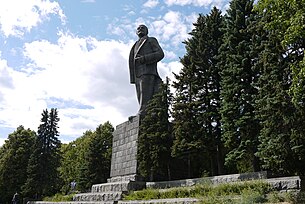Moscow Canal: Difference between revisions
m Reverted edits by 192.121.113.96 (talk) to last version by Beyond My Ken |
Undid revision 700057976 by Beyond My Ken (talk) |
||
| Line 47: | Line 47: | ||
}} |
}} |
||
{{refimprove|date=February 2013}} |
{{refimprove|date=February 2013}} |
||
The '''Moscow Canal''' ({{lang-ru|Кана́л и́мени Москвы́}}), named the '''Moskva-Volga Canal''' until |
The '''Moscow Canal''' ({{lang-ru|Кана́л и́мени Москвы́}}), named the '''Moskva-Volga Canal''' until 1947, is a [[canal]] that connects the [[Moskva River]] with the [[Volga River]]. It is located in [[Moscow]] itself and in the [[Moscow Oblast]]. The canal connects to the Moskva River in [[Tushino]] (an area in the north-west of Moscow), from which it runs approximately north to meet the Volga River in the town of [[Dubna]], just upstream of the dam of the [[Ivankovo Reservoir]]. The length of the canal is 128 km. |
||
It was constructed |
It was constructed between 1932 and 1937<ref>Maunch, C Zeller, T (2008) Rivers in History: Perspectives on Waterways in Europe and North America, University of Pittsburgh Press P73</ref> by [[Gulag]] prisoners during the early to mid [[Joseph Stalin|Stalin]] era, under the direction of [[Matvei Berman]]. During the process, about 22,000 prisoners died.<ref>[[Willi Münzenberg]]</ref> |
||
Thanks to the Moscow Canal, Moscow has access to five seas: the [[White Sea]], [[Baltic Sea]], [[Caspian Sea]], [[Sea of Azov]], and the [[Black Sea]]. This is why Moscow is sometimes called the "port of the five seas" ({{lang|ru|порт пяти морей}}). Apart from transportation, the canal also provides for about half of Moscow's water consumption, and the shores of its numerous reservoirs are used as recreation zones. |
Thanks to the Moscow Canal, Moscow has access to five seas: the [[White Sea]], [[Baltic Sea]], [[Caspian Sea]], [[Sea of Azov]], and the [[Black Sea]]. This is why Moscow is sometimes called the "port of the five seas" ({{lang|ru|порт пяти морей}}). Apart from transportation, the canal also provides for about half of Moscow's water consumption, and the shores of its numerous reservoirs are used as recreation zones. |
||
Revision as of 14:16, 16 January 2016
| Moscow Canal | |
|---|---|
| File:MoscowChannel.jpg | |
| Specifications | |
| Locks | 8 |
This article needs additional citations for verification. (February 2013) |
The Moscow Canal (Russian: Кана́л и́мени Москвы́), named the Moskva-Volga Canal until 1947, is a canal that connects the Moskva River with the Volga River. It is located in Moscow itself and in the Moscow Oblast. The canal connects to the Moskva River in Tushino (an area in the north-west of Moscow), from which it runs approximately north to meet the Volga River in the town of Dubna, just upstream of the dam of the Ivankovo Reservoir. The length of the canal is 128 km.
It was constructed between 1932 and 1937[1] by Gulag prisoners during the early to mid Stalin era, under the direction of Matvei Berman. During the process, about 22,000 prisoners died.[2]
Thanks to the Moscow Canal, Moscow has access to five seas: the White Sea, Baltic Sea, Caspian Sea, Sea of Azov, and the Black Sea. This is why Moscow is sometimes called the "port of the five seas" (порт пяти морей). Apart from transportation, the canal also provides for about half of Moscow's water consumption, and the shores of its numerous reservoirs are used as recreation zones.
One of the world's tallest statues of Vladimir Lenin, 25-meter (82 ft) high, built in 1937, is located at Dubna at the confluence of the Volga River and the Moscow Canal. The accompanying statue of Joseph Stalin of similar size was demolished in 1961 during the period of de-stalinization.[3]

References
- ^ Maunch, C Zeller, T (2008) Rivers in History: Perspectives on Waterways in Europe and North America, University of Pittsburgh Press P73
- ^ Willi Münzenberg
- ^ Salys, Rimgaila (2009). The Musical Comedy Films of Grigorii Aleksandrov: Laughing Matters. Intellect Books. p. 271.

